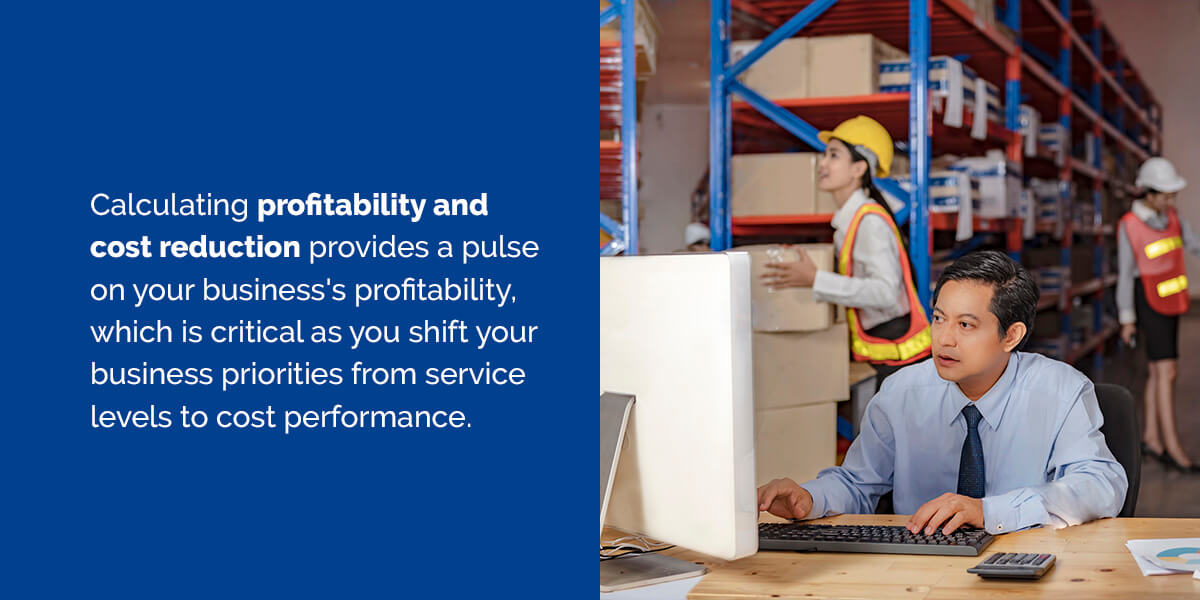3 Supply Chain KPIs to Prioritize When Preparing for a Recession

April 28, 2023
Lean economic times result in less consumer spending and smaller profit margins for your business. Many companies are unprepared when a recession strikes, turning to risky supply chain practices that can harm them. By proactively implementing the right strategies, you can minimize a recession’s effect on your company and make an easier recovery.
One of the best steps you can take to recession-proof your supply chain is leveraging the power of data. Tracking certain key performance indicators (KPIs) provides insight into your company’s supply chain’s health and its ability to withstand a recession and puts you in control of your supply chain. Knowing the best supply chain metrics to measure in a recession helps you at every stage, from preparing for it to minimizing disruptions to supporting you during recovery.
1. Cash Conversion
The cash conversion KPI, also called the cash conversion cycle, is the ratio between a company’s cash flow and its accounting profit. This metric determines how many days it takes for your company to convert its inventory and resources into cash flow. Essentially, cash conversion measures how long each dollar invested in inventory and resources spends in the production and sales processes before it’s converted into net profit.
The cash conversion KPI considers how long it takes for your company to sell inventory, collect receivables, and pay its bills. To find cash conversion, add days of inventory outstanding (DIO) and days sales outstanding (DSO), then subtract days payables outstanding (DPO). DIO and DSO are linked to your cash inflows, while DPO is related to your cash outflow. These metrics indicate how efficiently your operations can convert invested cash into sales.
Why Measuring Cash Conversion Matters in a Recession
Calculating cash conversion is critical during a recession when businesses prioritize preserving cash. During a recession, companies conserve as much of their cash flow as possible and lower the cash conversion cycle. A lower cash conversion or one that consistently trends downward is ideal because it indicates that a business is quickly turning cash from investment into profit.
When cash is readily available, you can make and sell more products for profit. But what about during a recession when companies struggle with mismanaged inventory, decreased sales, and increasing payables? Consider a few strategies for lowering the cash conversion KPI:
- Utilize tools such as Vendor Managed Inventory (VMI) to predict inventory replenishment levels and reduce your DIO.
- Automate invoicing to reduce errors and delays and lower DSO as much as possible.
- Renegotiate payment terms to make it easier for customers to pay invoices on time.
2. Profitability and Cost Reduction
Profitability and cost reduction are two more supply chain metrics that matter in a recession. Understanding profitability and cost reduction is critical in measuring how lucrative a company is. These metrics help supply chain managers and executives maintain lean operations while preserving their profit margins.
Businesses measure profitability with two important KPIs — gross profit margin and net profit margin. Gross profit margin, expressed as a percentage, reveals how much it costs to produce the items sold. To find the gross profit margin, divide gross profit by net sales. Net profit margin is a more comprehensive KPI that accounts for a company’s total profit after accounting for all expenses. Divide net income by revenue to calculate net profit margin.
Cost reduction measures the savings achieved directly through cost-cutting measures. Companies calculate cost reduction by comparing the price of producing a product or delivering a service before and after implementing a cost management technique.
Why Measuring Profitability and Cost Reduction Matters During a Recession
Calculating profitability and cost reduction provides a pulse on your business’s profitability, which is critical as you shift your business priorities from service levels to cost performance. However, many companies respond to a recession by haphazardly cutting costs wherever possible. This approach can weaken a company’s ability to rebound from the economic downturn by damaging long-term relationships, scalability, assets, and other factors that affect future success. Instead, a cost-reduction strategy improves efficiency while assessing the implications of each cost-cutting measure on the entire business.
During the onset of the COVID-19 pandemic in early 2020, Trau & Loevner used TrueCommerce EDI to navigate an increasingly online market. The apparel company saw sales at retail stores come to a standstill while eCommerce orders skyrocketed. Trau & Loevner saw an opportunity to increase profitability by delivering products through a different sales channel, but they needed effective solutions.
Trau & Loevner automatically transferred order data using TrueCommerce EDI to its ERP, helping the company adjust to shifting order quantities and manage high cancellations from retailers. Once retailers started opening back up, Trau & Loevner utilized EDI to speed up order processing and effectively fill large order volumes, taking advantage of a changing market to maintain profitability.
3. Supplier Performance
Supplier performance KPIs provide insight into a supplier’s financial health. Continually monitoring supplier performance and collaborating on solutions is an important way to improve supplier relationships. The supplier KPIs you should be tracking include:
- Lead times: The time between when an order is placed and when it is fulfilled is the lead time. The shorter the lead time, the better.
- Perfect order: This KPI tracks damage-free delivery, on-time delivery, accurate documentation, and in-full delivery.
- Compliance: Every supplier must comply with industry or trading partner requirements, such as EDI mandates. Tracking compliance shows you how well a supplier is managing compliance.
- Fill rate: A supplier’s fill rate is the number of orders it can fulfill before running out of inventory.
Why Measuring Supplier Performance Matters in a Recession
During a recession, companies use supplier performance KPIs to determine whether a supplier is going out of business and make relationships with more stable trading partners. It’s critical to remember that supplier performance metrics can change over time with new strategies. A supplier enablement platform provides reporting on supplier performance, so you can automate tracking these metrics.
Collecting and tracking supplier performance KPIs helps your company maintain scalability during and after a recession and builds your understanding of which suppliers are most important to your operations based on factors like whether the supplier is a single source and the revenue they yield.
Prepare for a Recession by Tracking Supply Chain KPIs
Measuring critical KPIs regarding supplier performance, profitability, and cash conversion helps your company handle the significant supply chain management challenges that recessions bring. Although there is always time to increase your supply chain’s resilience, taking a proactive approach to recession-proofing your supply chain by tracking these KPIs allows your business to stay ahead of a recession and emerge ready to continue growth.
With supply chain solutions from TrueCommerce, such as EDI, VMI software, and supplier enablement, your company can gain enhanced visibility into your supply chain and track various KPIs to grow, even through a recession. For more information about our solutions, contact us or try our platform for yourself with a free demo.
Share this post:
Stay ahead of the competition
Get expert supply chain insights delivered directly to your inbox weekly.
